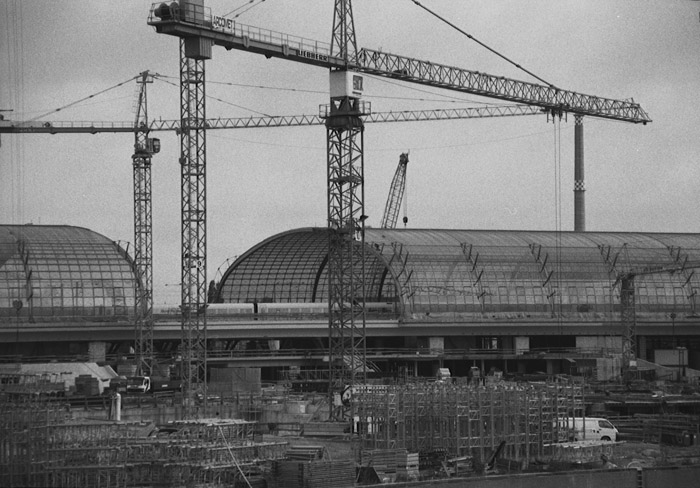The railway station, as a building type, has had its ups and downs over the last two centuries. From its humble beginnings in Liverpool, it evolved into the grandiose cathedrals of St Pancras, London, Grand Central Terminal, NYC or the Victoria Terminus in Bombay.
Then, at some point in the middle of the last century, they fell from grace. From being the cathedrals of modern rapid transport, the railway stations became the local epi-centre of urban vice when airports became the glamorous, nodes of travel. King’s Cross, London, and Københavns Hovedbanegård would two examples.
Lately though, as airports become ever less glamorous and environmentally abominable in the public eye, railway stations have, during the last decades, yet again become monumental cathedrals of transportation. The train station has come out of hiding and claims space in the city where it becomes the most important of transportation nodes.
Berlin has got a brand spanking new train station (Berlin Hauptbahnhof), it was opened as late as in 2006, and is currently the largest crossing station in Europe. It is located in Moabit, an area that was more or less wall adjacent during the cold war. Large parts of the area were empty when the wall came down and a lot of government buildings sprang up south of the station during the early nineties when money poured into the city.
The station itself was the last of these grand projects to be completed, long after the steam had gone out of the over-optimistic post-wall Berlin. The final cost of the construction landed somewhere around €700,000,000.
The thing that interests me with train stations is usually not the actual building, but what kind of urban environment that surrounds it, the local context, from King’s Cross’ (formerly) seedy context to Venice’s glorious embankment, the area around train stations is never really dull.
Today, the Hauptbahnhof sits in, more or less lone majesty, surrounded by parking lots, wasteland and the river. With the railway stations’ refound status, I’ve been curious regarding what will grow up around the Hauptbahnhof, until last week when the plans for the area immediately south of the station were presented in a number of local newspapers.
Basically the plan is to construct a whole batch of hotels, totaling approximately 1,200 beds, mostly orientated to a budget market, a congress centre for 3,500 people and 300 or so car parking spaces.
Well, I can understand that tourism is one of the expanding industries in Berlin, and the fact that there is a lack of centrally located congress centres as far as I can understand. But that’s basically as far as I can sympathize with this plan. To create a tourist enclave in the middle of Berlin, isolated by government offices that are empty in the evenings, train tracks and the river is just idiotic.
First of all, this area could be so much more, it needs to become integrated with Berlin, not isolated from it. The Hauptbahnhof is not an airport in the middle of nowhere, it is an extremely central part of the city. To create a tourist island here is to separate it from the rest of the city.
Secondly, any urban area needs to develop over time, instant programs of a larger scale focusing on one function usually become very dreary. Any major European city has a number of more or less failed (on an urban level) large scale single function developments, especially those developed in a haste.
Thirdly, is it even going to be attractive to tourists? The reason you go to Berlin as a tourist is for the vibrant mix of everything, it is functionally quite an integrated city. Cheap bars next expensive hotels, squats next to banks, there’s always a surprise down every street. We all know that’s not going to last, but that’s no reason to speed up the generification (is that a proper word actually?) of Berlin willfully.
I do appreciate that the incentive for this is economical and my arguments against it aren’t very economical. I do also appreciate the fact that Berlin is still a scarred city with many blanks in the urban fabric, and some people are itching to mend them. But I can’t help but feel that the city sells itself short, over and over again.
There are lots of examples, read Architecture in Berlin’s posts on Mediaspree, or Alexanderplatz. The blanks in the urban fabric, that some are so eager to fill in, are part of what gives Berlin unique charm. The undefined spaces, that with temporary modification can become anything, allow things to prosper, ideas, art, clubs and so forth that would never even be able to survive for a week elsewhere.
However, this will most likely give Berlin something else that’s unique; a dull area just outside a major railway station.


Leave a comment